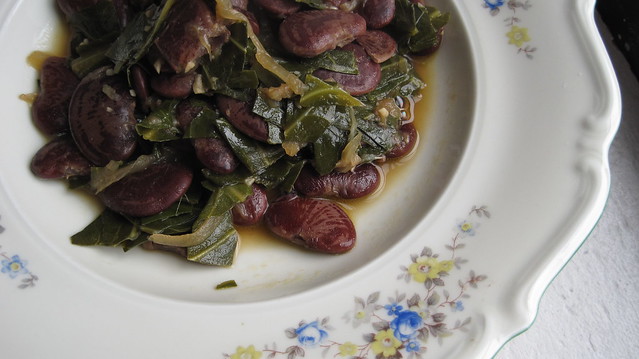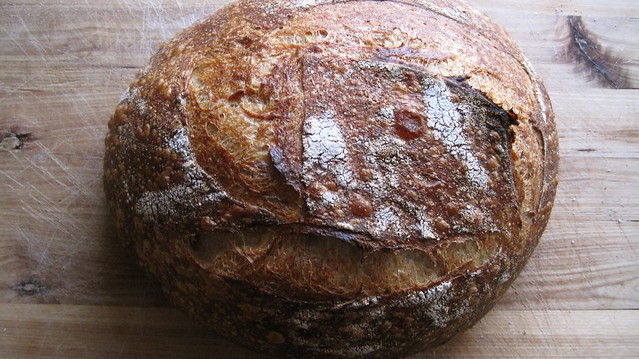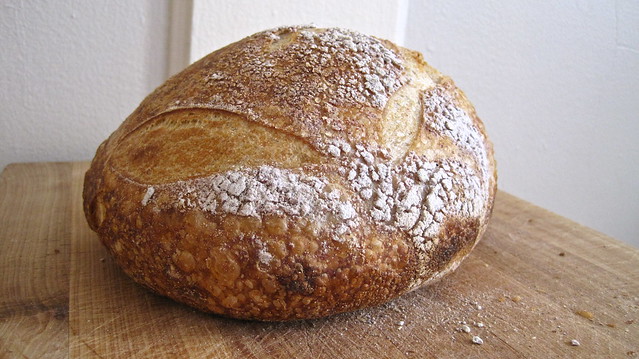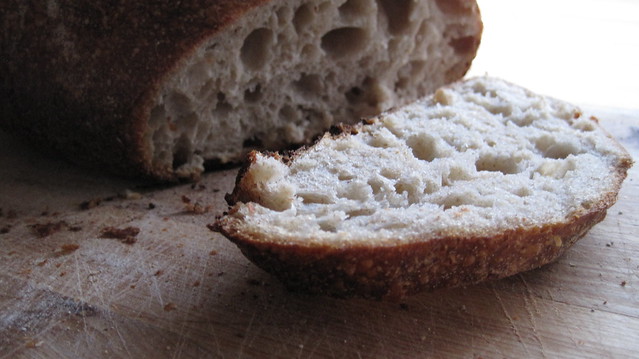Save this one for a cold, drizzly day. I think that we've seen the last of those for a while here in Chicago. And even so, that won't be enough keep me from what remains of this gumbo. Have you ever had something made with a brick roux? It's what makes this gumbo. Like any roux, it's just fat and flour--the magic of it is in the extended spell it spends in the oven, getting dark and smoky, with a savour unlike anything else I've ever tasted. It permeates the gumbo and lingers on tongue, leaving you a little wide-eyed, a little desperate for more. Brick roux is a serious and heady affair.
But that doesn't make it difficult. Just lug out your trusty cast-iron dutch oven (or another heavy-bottomed, oven-proof vessel of your choosing), whisk together equal amounts of flour and oil, and let things work their magic in the oven. In about an hour and a half, you'll have a rich, dark red paste--the real soul of your gumbo. The rest is a matter of sautéing and simmering, as you might expect--a mirepoix of onion, celery, and green pepper (the Cajun trinity), creamy beans, some collards, if you like. Irresistible on a cold, dark day, (though I might not wait even that long to make this again--I have a friend who strongly hinted that he'd welcome some more soon, despite the heat).
A final note about brick roux and gumbo. Unlike the sort of roux you're likely familiar with--pale and prized for its thickening power in béchamel and the like--brick roux is all flavour and won't do any work when it comes to thickening your gumbo. For this, turn to filé powder, the ground leaves of the sassafras plant, which, I'm told, is the traditional ingredient for thickening gumbo. The powder also adds a slight lemony note to the gumbo and complements the savour of the roux. If you can't find filé, a handful of chopped okra is a good second. I actually prefer okra, even if it flouts tradition. Decide for yourself the next time you're in need of something to warm you.
Adapted from Alton Brown and Deborah Madison's Vegetarian Cooking for Everyone
Note: a few things--first, the beans. If you can find yourself a bag of Camellia Brand red kidney beans from Louisiana, good on you. According to Cook's Illustrated, anyway, they're the preferred bean of New Orleans cooks--thin-skinned and very creamy. Otherwise, you might try the more widely available Mexican Red bean. Personally, I like the Brown Tepary bean, which you can find at Rancho Gordo. It has a nice grassy sweetness that complements the smokiness of the gumbo (the beans pictured above are butter beans--also good but not particularly noteworthy). Second, I like to give my roux an extra 10 minutes in the oven. The one time I didn't, it didn't quite have its usual smoky intensity. Don't get too daring with it, though--you want brick roux not blackened roux. Also, please use care when handling your roux--it is, after all, very hot fat and flour. Finally, filé powder, the ground leaves of the sassafras plant, is the traditional thickener in gumbo, and you can find with the other spices at a well-stocked grocery store or at a place that specialises in Cajun food. Otherwise, okra is a fine substitute and will thicken your gumbo just the same.
8 oz dried beans, sorted and soaked (see note above)1/2 teaspoon sea salt
4 oz vegetable oil
4 oz all-purpose flour
4 cups good-quality vegetable broth
1 medium onion, diced
1 small green bell pepper, diced (about a 1/2 cup)
2 stalks of celery, diced
4 cloves garlic, minced
1/2 cup peeled, seeded, and chopped tomato
1/2 teaspoon freshly ground black pepper
1 teaspoon fresh thyme, chopped
1/4 teaspoon cayenne pepper
2 bay leaves
2-3 cups collard greens, chopped
1 tablespoon filé powder or 2 oz okra, trimmed and chopped into 1/2-inch pieces
Salt to taste
Preheat the oven to 350 degrees F.
Place the oil and flour in a 5- to 6-quart cast-iron dutch oven and whisk into a smooth paste. Place the dutch oven on the middle shelf of the oven and bake, uncovered, for 1 1/2 hours--give or take 15 minutes--whisking two to three times throughout the cooking process.
Meanwhile, place the beans in a 2-quart saucepan with enough water to cover them by an inch. Add the salt. Bring to a boil over medium heat. Leave them cooking at a hard boil for 5 minutes, skimming off any foam that rises to the surface. Reduce heat to low and gently simmer, covered, until beans are tender. Cooking times vary widely between bean varietals.
When the roux is done, carefully remove it from the oven and set it over medium-high heat. Gently add onions, green pepper, celery, and garlic and cook, stirring constantly for 7 to 8 minutes or until the onions are translucent.
Add the tomatoes, black pepper, cayenne, thyme, and bay leaves and stir to combine. Gradually add the vegetable broth while stirring continuously. Reduce the heat to low and cook, covered, for 20 minutes. Then add the collards and beans and cook for 20 minutes more--if using okra, add 10 minutes in. Salt to taste (with the vegetable broth I use, I find that salt isn't necessary).
Turn off the heat. Add filé while stirring constantly. Cover and let sit for 10 minutes. Serve over rice.
Serves 6-8






